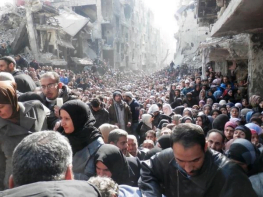UPDATE: The vote is scheduled for tomorrow morning.
The Security Council’s work on Syria is reaching a critical point. Jordan, Luxembourg and Australia have presented a draft resolution that would compel the Syrian government and armed groups to allow humanitarian assistance to reach besieged populations. It is due to be voted on tomorrow Saturday, but it is still unclear whether or not Russia will veto the resolution.
The outcome of this vote will directly affect the fate of over 6.5 million people in need inside Syria. But there is much more at stake than humanitarian access.
Last fall, the Security Council found unity for the first time on Syria over its chemical weapons program. The outcome of that moment of unity was two fold. Most immediately, it provided for the quarantine of Syria’s chemical weapons. It also provided some momentum toward progress on the humanitarian front. Shortly after the chemical weapons resolution was passed, the Council unanimously agreed (in a statement) on the need for humanitarian access inside Syria.
There was progress on the political front, too. In January, at the cajoling of Russia and the USA, the warring factions met face-to-face for the first time in for peace talks in Geneva. One issue on the table was a “good faith” agreement on a humanitarian ceasefire in the city of Homs.
Earlier this month, the UN finally brokered that ceasefire. This allowed humanitarian supplies into a besieged neighborhood and an evacuation of the sick and vulnerable. It also provided a proof of concept that humanitarian pauses can be achieved.
With proof in hand and diplomatic momentum behind them, western countries (and Jordan) have been pushing for a more comprehensive resolution that would guarantee humanitarian access to populations in need throughout Syria. By dint of being a Security Council resolution, this would carry the force of law. But Russia is wavering. It’s principle objection is that the resolution on the table may be used as a cover to impose punitive measures on the Syrian government. To wit, the last sentence of the resolution reads:
Requests the Secretary-General to report to the Council on the implementation of this resolution by all parties in Syria, in particular paragraphs 2 through 12, in 30 days of its adoption and every 30 days thereafter, and upon receipt of the Secretary-General’s report, expresses its intent to take further steps in the case of non-compliance with this resolution;
In other words, the resolution would require Ban Ki Moon to report back on whether or not the Syrian government is blocking humanitarian aid from reaching populations in need. If he finds it is, the Security Council could start debating ‘further steps’ to enforce the resolution. That is diplomatic code for punitive measures like sanctions or even something stronger, and it’s these ‘further steps’ that bother Russia. Moscow’s overriding goal is to prevent international intervention. That means blocking any possible path to intervention.
The drafters of this resolution are well aware of Moscow’s concerns. At the same time, they want the resolution to have some bite. So instead of outright threatening Syria in the case of non-compliance, they inserted an implied threat that punitive measures may be considered in the future. This weakens the resolution, but could be enough to bring Moscow on board. After all, they could always veto these ‘further steps’ when the time comes.
On the other hand, if Moscow vetoes this resolution it would all but end the limited progress there has been on humanitarian access inside Syria. It would be a profound display of acrimony and disunity at the Security Council and likely signal the end of the ongoing peace talks in Geneva.
A failure of this resolution would signal that the ability of the Security Council to positively affect events on the ground was ephemeral.
Credit: UNRWA/SStevenson Yarmouk Camp, Rural Damascus (February 2014) – Palestine
refugees queue amongst the damaged buildings in Yarmouk Camp to receive the first humanitarian assistance to since July 2013.
